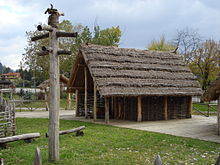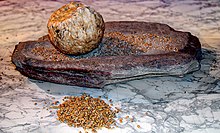Neolithic
The Neolithic Era, or Period, from νέος (néos, "new") and λίθος (líthos, "stone"), or New Stone Age, is the final division of the Stone Age, with a wide-ranging set of developments that appear to have arisen independently in several parts of the world. It is first seen about 12,000 years ago when the first developments of farming appeared in the Epipalaeolithic Near East, and later in other parts of the world. The Neolithic lasted (in that part of the world) until the transitional period of the Chalcolithic from about 6,500 years ago (4500 BC), marked by the development of metallurgy, leading up to the Bronze Age and Iron Age.




The Neolithic introduced the Neolithic Revolution or "Neolithic package", comprising a progression of behavioral and cultural characteristics and changes, above all the introduction of farming and use of domesticated animals.
Quotes
edit- It is the retention by twentieth-century, Atom-Age men of the Neolithic point of view that says: You stay in your village and I will stay in mine. If your sheep eat our grass we will kill you, or we may kill you anyhow to get all the grass for our own sheep. Anyone who tries to make us change our ways is a witch and we will kill him. Keep out of our village.
- Carleton S. Coon, The Story of Man, (1954).
- The more we progress the more we tend to progress. We advance not in arithmetical but in geometrical progression. We draw compound interest on the whole capital of knowledge and virtue which has been accumulated since the dawning of time. Some eighty thousand years are supposed to have existed between paleolithic and neolithic man. Yet in all that time he only learned to grind his flint stones instead of chipping them. But within our father's lives what changes have there not been? The railway and the telegraph, chloroform and applied electricity. Ten years now go further than a thousand then, not so much on account of our finer intellects as because the light we have shows us the way to more. Primeval man stumbled along with peering eyes, and slow, uncertain footsteps. Now we walk briskly towards our unknown goal.
- Arthur Conan Doyle The Stark Munro Letters (1894)
- The end of the Neolithic age betokens almost as universal a re-orientation of life, almost as profound a revolution of economy and society, as its beginning. Then the break was marked by the transition from mere consumption to production, from primitive individualism to co-operation, now it is marked by the beginning of independent trade and handicrafts, the rise of cities and markets, and the agglomeration and differentiation of the population.
- Arnold Hauser. The Social History of Art, Volume I. From Prehistoric Times to the Middle Ages, 1999
- Archaeological evidence suggests that humans adopted new ways of processing food during the Neolithic which included the use of grinding stones and cooking in ceramic vessels (Larsen 2006; Meller et al. 2009). This is supported in Neolithic samples by a pattern of decreased skull size and shape and dental microwear evidence (Larsen 2006; Sardi et al. 2004). Bone responds to high amounts of physical activity and stress by increasing in mass (Larsen 2006: 16). Paleolithic hunter-gatherers likely had larger skulls than Neolithic peoples due to their more mobile and active lifestyle (Sardi et al. 2004). "It is accepted that masticatory forces regulate craniofacial growth and the stress is mainly due to the food consistency that causes variations in the mastication movement" (Sardi et al. 2004: 141). This means that facial structures are suited to individual chewing needs. When new preparation and processing methods were introduced, foods became softer and easier to chew. Over time this change in masticatory function contributed to an overall "gracilization" of the human skull and resulted in a smaller human face with reduced jaws and teeth (Larsen 1991, 2006; Sardi et al. 2004).
- Katherine J. Latham, “Human Health and the Neolithic Revolution: an Overview of Impacts of the Agricultural Transitionon Oral Health, Epidemiology, and the Human Body”, (2013), Nebraska Anthropologist, 187, p. 96.
- Cities and other large settlements appeared for the first time during the Neolithic. Pathogens require a large host to thrive and these large, crowded populations provided a human host population that had not previously existed among hunter-gather societies (Armelagos et al. 1991:15). Now able to spread easily from person to person in the crowded conditions of cities, pathogens were able to exploit entire groups and reach endemic levels (Armelagos et al. 1991; Papathanasiou 2005). Crowded conditions paired with human settlements in close proximity to animals also contributed to high rates of infectious disease. In many early agricultural communities, animals were kept both near to and inside of houses. This proximity allowed some zoonotic diseases to transfer from animals to humans (Armelagos et al. 1991; Eshed et al. 2010). Contaminated water sources and close contact with human waste also facilitated parasitic infection in both animals and humans (Armelagos et al. 1991; Larsen 2006; Papathanasiou 2005). The increase of infectious disease associated with the adoption of an agricultural lifestyle did not necessarily increase mortality (Eshed et al. 2010). Those most likely to suffer fatal infections would have been infants, young children, and the elderly. Individuals who reached reproductive age had likely developed a resistance to such diseases (Armelagos et al. 1991).
- Katherine J. Latham,“Human Health and the Neolithic Revolution: an Overview of Impacts of the Agricultural Transitionon Oral Health, Epidemiology, and the Human Body”, (2013), Nebraska Anthropologist, 187, p. 97-98.
- The transition to agriculture in the Neolithic was arguably one of the most drastic lifestyle changes in human history. Changes in diet, living conditions, and subsistence activities had an enormous impact on human health, though effects varied from region to region. Skeletal analysis of these early agricultural communities suggests that the transition to agriculture had an overall negative impact on human oral health, increased the incidence of infectious disease and nutritional deficiencies, and contributed to an overall reduction in human stature.
- Katherine J. Latham, “Human Health and the Neolithic Revolution: an Overview of Impacts of the Agricultural Transition on Oral Health, Epidemiology, and the Human Body”, (2013), Nebraska Anthropologist, 187, p. 101.
- The extraordinary productivity of modern farming techniques belies just how precarious life was for most farmers from the earliest days of the Neolithic revolution right up until this century (in the case of subsistence farmers in the world’s poorer countries). Both hunter-gatherers and early farmers were susceptible to short-term food shortages and occasional famines – but it was the farming communities who were much more likely to suffer severe, recurrent and catastrophic famines.
- James Suzman, “How Neolithic farming sowed the seeds of modern inequality 10,000 years ago”, The Guardian, (5 Dec, 2017).
- Neolithic farmers assumed full responsibility for “making” their environments provident. They depended on a handful of highly sensitive crops or livestock species, which meant any seasonal anomaly such as drought or livestock disease could cause chaos.
And indeed, the expansion of agriculture across the globe was punctuated by catastrophic societal collapses. Genomic research on the history of European populations points to a series of sharp declines that coincided first with the Neolithic expansion through central Europe around 7,500 years ago, then with their spread into north-western Europe about 6,000 years ago.
However, when the stars were in alignment – weather favourable, pests subdued, soils still packed with nutrients – agriculture was very much more productive than hunting and gathering. This enabled farming populations to grow far more rapidly than hunter-gatherers, and sustain these growing populations over much less land.
But successful Neolithic farmers were still tormented by fears of drought, blight, pests, frost and famine. In time, this profound shift in the way societies regarded scarcity also induced fears about raids, wars, strangers – and eventually, taxes and tyrants.- James Suzman, “How Neolithic farming sowed the seeds of modern inequality 10,000 years ago”, The Guardian, (5 Dec, 2017).
- A recent research paper examining inequality in early Neolithic societies confirms what early-20th century anthropologists already knew, on the basis of comparative studies of farming societies: that the greater the surpluses a society produced, the greater the levels of inequality in that society.
The new research maps the relative sizes of people’s homes in 63 Neolithic societies between 9000BC and 1500 AD. It finds a clear correlation between levels of material inequality – based on the size of household dwellings in each community – and the use of draught animals, which enabled people to put far greater energy into their fields.- James Suzman, “How Neolithic farming sowed the seeds of modern inequality 10,000 years ago”, The Guardian, (5 Dec, 2017).